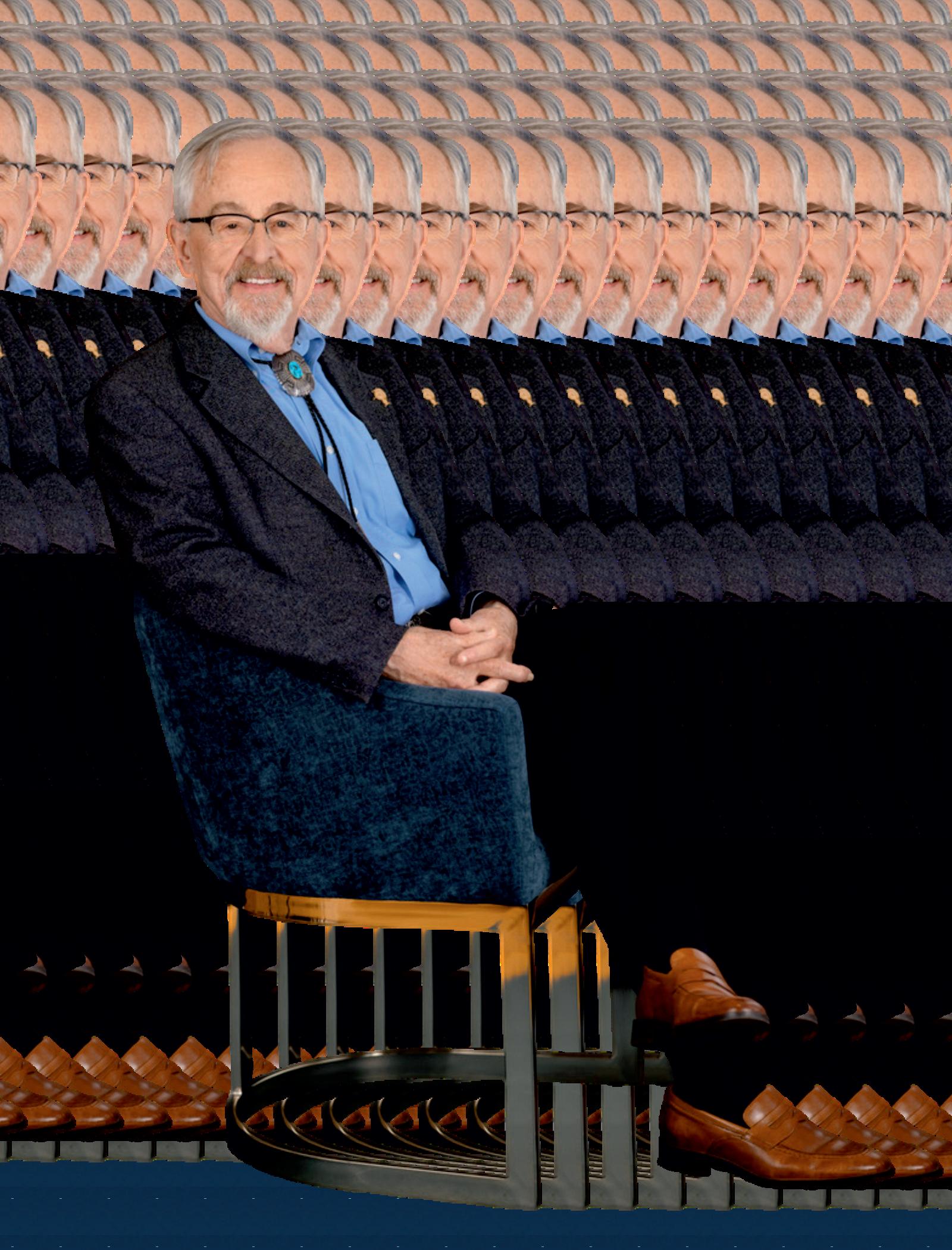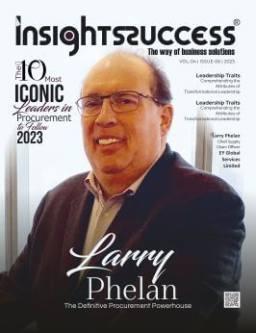


























N o t e
Throughouthistory,certaineducatorshave
transcendedthetraditionalrolesofteachingand researchtobecomecatalystsofinnovation, change,andinspiration.Theychallengeconvention,push thefrontiersofknowledge,andnurturegenerationsof thinkers,doers,andleaders.Theyarearchitectsofnew disciplines,pioneersoftransformativemethodologies,and championsofeducationasaforceforsocietalgood.Their impactisfeltnotonlyinacademicjournals,butinthe communities,theyserve,thetechnologiestheyhelpshape, andtheglobaldialoguestheyinfluence.Onesuch visionaryisProf.RichardCharlesLarsonwhohasspent adistinguishedcareertransformingtechnicalknowledge intotoolsforsocialbetterment.
InsightsSuccessinrecenteditiontitledTheProfessorof PossibilitiestracesLarson’sjourneyfromacuriousboyin ruralPennsylvaniatoacelebratedMITprofessor,systems

innovator,andglobalthoughtleader.Hisworkin operationsresearch,especiallyqueueingtheory,has shapedreal-worldsystemsinpolicing,healthcare,and disasterresponse.Simultaneously,hispassionfor educationledtogroundbreakinginitiativeslikeLINCand BLOSSOMS,bringinginteractiveSTEMlearningto underservedcommunitiesworldwide.WhatmakesLarson exceptionalisn’tjusthistechnicalbrilliance,it’shis human-centeredapproach.
Aswenavigateafutureincreasinglydefinedby complexityandrapidchange,voiceslikeDr.Larson’s offerbothclarityandinspiration.Heremindsusthatthe toolsofscienceandengineeringarenotonlyforbuilding systemsbutalsoforimaginingnewpossibilitiesfor society.
Haveagreatreadahead!

18

A R T I C L E S
22 F e a t u r i n g 08
Propelling Innovation
How to Implement Effec�ve Engineering Solu�ons?
From Data to Decisions
How to Apply Opera�ons Research in Business Decisions?










I

always liked to figure out how the world worked, and putting math to all that.
“ “
The
Inatimemarkedbyturbulenceandintricatechallenge, fewhavehelpedtolightthewayfromdifficultyto possibilityasmuchasProfessorRichardC.Larson Populararoundtheworldas"Doctor Queue,"Larson's professionaljourneyatMITandbeyondhasservedasa witnesstothetransformativepowerofinquiry,persistence, andtheongoinghumanurgetomakeapositiveimpact.
Larson'sjourneystartsinBayside,Queens,NewYork,in 1943.Hisearlyyears,though,playedoutagainstthe backdropofvariousAmericanlandscapes,each contributingtohisworldviewandpersonality WhenLarson wasfive,hisfamilyrelocatedtoSunbury,Pennsylvania-a small,ruralfarmingtown.There,setamidstopenfieldsand woodlands,Larsonlearnedtheimportanceofexploringand beingindependentforthefirsttime.
Apivotalexperienceinhisyouthsaysalotabouthowhe grewupandwhatvalueswereimpartedbyhisparents. Whenhecameofageforkindergarten,hisparentsgavehim achoice:gotokindergartenorstayathomeanotheryear."I thought that was pretty cool,"heremembered.Followinga weekendofconsideration,youngLarsondecidedtostaya childforanotheryear,playingoutsideandlearningfromthe worldaroundhim.Whenhefinallyenrolledinfirstgrade, helaggedbehindhispeers,unabletocounttotenorsign hisname.Butwithtypicalresolve,hesooncaughtup-a harbingerofthepersistenceandflexibilitythatwould characterizehissubsequentcareer.
Larson'sinterestinmathandthephysicalsciencesbegan earlyandintensifiedeachyear AtNeedhamHighSchool, outsideBoston,hewasoneofthefirsttoenrollinMIT's
Teaching and research kind of are meshed like this-today’s research results go into “ “
newPSSEphysicscourse,abyproductofthepost-Sputnik era'semphasisonscientificachievement.Thismathematicsinfusedcourse,whichconnectedmathwiththephysical world,revolutionizedLarson'slearning.“Isortoffellin lovewiththatwayoflearning,andofresearch,andof science,”hesaid.Thisexperiencedidnotonlysolidifyhis loveforscience,butalsoplaceMITonhisradarasa destinationwherethosepassionscouldbepursuedattheir highestlevel.Byhisfourthyear,MITwashis"stretch school"-somethinghehopedtoaimfor,butneverthought thathewouldeveractuallygetthere.
Larson'sacceptancetoMITwasexcitinganddaunting.As withmanyoutstandingstudents,heatfirstassumedthathis invitationwasanerror.Theculturaldiversityandacademic excellenceofthestudentsaroundhim-fromArgentina, Austria,Italy,Cuba,Iowa,andCalifornia-wasinspiring and,attimes,humbling.Butashebecameimmersedin MIT'scooperativecultureofanalyticalintensity,hefound hisniche.


“When you work hard, and you earn competitive grades, and your peers accept you as a supporting colleague, you know you belong,”hesaid.Hedecidedtomajorin ElectricalEngineering(Course6),motivatedbybothfamily tradition-hisfatherwasanelectricalengineer-andthefield's reputationfordevelopingsystematic,quantitativethinking.
“If you don't know what you're going to do, but you want to bring systematic reasoning, quantitative reasoning, to bear on the world, the default choice here on campus has been, and remains, I think, Course 6, Electrical Engineering and now Computer Science. Because it conditions your mind to think systematically about hard problems in ways which are very useful, regardless of what you do later,"Larsonsaid.
TheAccidentalPhD:SeizingOpportunity
Larson'scoursetograduatestudiesatMITwas,according tohisownself-description,unplanned.BroughtintoMIT onaMaster'sdegreeinvitationthroughafellowshipfrom BellLaboratories,hewasurgedonbymentorstofollow throughonearningaPhD.Inspiteofhisownfeelingsthat
hewasn't"doctoral material,"hewasbadgered-frequently atgreatlength-byteachersandpeersintopreparingforand sittingthequalifyingexams.
PayingthemleftthewaytoPh.D.study,onewhichhe didn'texpectbuttowhichhewouldbeoutstandinglywelladjusted.
AturningpointcameduringhisMITresidency,whenan theftinhisresidentialgroupgothiminterestedin examiningpoliceinvestigationpractices.Browsingthrough titles,hefoundhimselfborrowinganentirepileofdetective novelsinthelibrarywhichbecamenoticedbyhisadvisor ProfessorAlDrake.Seeingthepotentialforacademic research,DrakeurgedLarsontomakethisaformalareaof study Thisresultedinhismaster'sanddoctoraltheseson policing,hisfirstbook(UrbanPolicePatrolAnalysis),and evenapositionastheyoungestmemberoftheScienceand TechnologyTaskForceofthePresident'sCrime Commission.
I view operations research as the world’s most important invisible profession. “ “




BecomingafacultymemberatMITwasitsownchallenge. "You glance around, you see all these Nobel laureates, and members of the National Academy of Sciences and Engineering, you say, why am I here?"Larsonconfesses. Butashesatdowntowrite,doresearch,andworkwith students,hecameintohisown."You begin receiving research funding, and all of a sudden you feel you are in,” headds.Larson'shumilityandhumor-hecompareshisearly impostersyndrometoaGrouchoMarxroutine-havewon himovercolleaguesandstudentsalike.Overtime,hehas becomenotonlyarespectedscholar,butabelovedmentor andleader
Larson'steachingstyleismarkedbyexperimentation, activity,andafundamentalrespectforhisstudents."The greatest asset of MIT is our students,"hedeclares."They're very, very smart, they're very, very energetic, and you can experiment with them. Provided you challenge them and keep them engaged, they always return more than you give to them.”Hehasinstructedeverythingfromlarge undergraduatelecturesinappliedprobability-sometimes withmorethan350students-tosmallgraduateseminarsand freshmanseminarswithonlyeightstudents.Heenjoysthe variousdynamicseachenvironmentpresents,fromthe challengeofmotivatingalargelecturehalltothepleasure ofrichdiscussioninsmallergroups.
Asathesisadvisor,Larsonhassupervisedcountless master'sanddoctoralstudents,whomheregardsashis ‘academic children.’Severalofthemhavebecome professorsintheirownright,resultinginascholarship genealogythathasexpandedtoinclude‘grandchildren’and ‘great-grandchildren.’Larsoncountsthelegacyof mentorshipamonghismostcherishedachievements.
Larsonisaself-described“OR enthusiast.”Helikestotease aboutthemisunderstandingoftheterm-peoplethinkithas todowithmedicaloperatingrooms.Infact,ORisthestudy ofdecision-makingincomplicatedsystems,combining industrialengineering,managementscience,andapplied mathematics."I like to refer to it as the physics of the real world that includes people and technology,"hesays.

Hisinitialworkinoptimizingpolicepatrolsandemergency servicesystemswasestablishingnewbenchmarksforthe industry.Gradually,hewidenedhisresearchtocovera broadarrayofservicesystems,suchashealthcare,disaster management,manpowerplanning,anddynamicpricingof keyinfrastructures.
Larson'sworkinqueueingtheory,specifically,earnedhim themoniker"Doctor Queue."Notonlydidhecreatenew computationalmethods,buthealsoinvestigatedthe psychologicalandexperientialdimensionsofwaiting,so hisworkisapplicabletobothscholarsandpractitioners. Hisworkhasbeenextensivelyreportedinthemedia, demonstratingitswide-rangingimpactonsociety
Larson'scontributionstoqueueingtheoryhavebeen especiallyfar-reaching.HecreatedtheQueueInference Engine,acomputerprogramthatcanestimatequeueing parametersfromsparsedata-abreakthroughwith implicationsacrossthespectrumfromtelecommunications tohealthcare.HisHypercubeQueueingModelisawidely referencedstandardandhasbecomethego-totoolfor analyzingemergencyservicesystems.

Inadditiontothemath,Larsonhasprobedthepsychology ofwaiting,seeingthatjudgmentsaboutfairness,openness, andcommunicationcansignificantlyimpactpeople's experiences.Hisworkhasbeenembracedbyhospitalsas wellasamusementparks,indicatingtheapplied significanceofhisstudies.
Larson'sworkhasalsotranslatedtodisasterplanning, wherehehassimulatedevacuationplansandemergency responsesupplychains,andpublichealth,wherehis researchintodiseasedynamicsandvaccinedistributionhas beenusedtoinformpolicyandpractice.
Larson'sinfluencereachesfaroutsidetheclassroom.As directorofMIT'sCenterforAdvancedEducationalServices (CAES),hepromotedtheapplicationoftechnologyto increaseaccesstohigh-qualitylearning.Heenvisionedthe powerofonlineandblendedlearningwellbeforethese methodsbecamemainstream.
HisestablishmentoftheLearningInternationalNetworks Consortium(LINC)convenededucators,technologists,and policymakersfromacrosstheglobetodiscusshow technologymightdemocratizelearning.LINChasfunded projectsinAfrica,China,andtheMiddleEast,promoting
cross-culturalcollaboration andinnovation.
TheBLOSSOMSproject (BlendedLearningOpen SourceScienceorMath Studies)isareflectionof Larson'sdedicationto educationalequityaroundthe world.Throughthecreation anddisseminationof interactive,inquiry-based videolessonsinmathand science,BLOSSOMSenables teachersandstudentsglobally, especiallyinunderprivileged communities.
Larson'sownresearch leadershipisequally impressive.HewasacodirectoroftheMITOperations ResearchCenterformorethan15years,shapingthe researchagendaatthecenterandmentoringthefuture generationofacademics.Hisleadershipwasextended,too, whenhewasthedirectorofCAESandfounder-directorof LINC,whereheadvancedinnovationattheinterfacesof technology,education,andsociety.
Larsonhasalsobeenaprofessionalsocietyleader,having servedaspresidentoftheOperationsResearchSocietyof America(ORSA)andtheInstituteforOperationsResearch andtheManagementSciences(INFORMS).Heisan INFORMSfoundingfellowandhasbeenawardedits highestaccolades,includingthe President's Award andthe Kimball Medal.
I admire the approach to learning, and to research, and “ “
WhatdistinguishesLarsonishissteadfastdedicationtothe humanaspectofscienceandengineering.Heregards operationsresearchnotasatechnicalfield,butasawayto enhancepeople'sandcommunities'lives.Whether optimizingemergencyresponse,reducinghealthcare deliveryinefficiencies,orincreasingeducationalaccess,his workismotivatedbythegoalofmakingaconcrete difference.
Larson'scompassionandinquisitivenessarerevealedinhis workasascholar,educator,andleader.Heisthoroughly committedtohisstudents'achievement,challengingthem toexploregreatideasandtackletheworld'smost significantissues.Hismagnanimityofspiritandloveof discoveryhavemotivatednumerouscolleaguesand protégés.
Larson'sworkhasbeenhonoredwithmanyawards,suchas the Frederick W. Lanchester Prize,the INFORMS President's Award,the Kimball Medal,and membership in the National Academy of Engineering.Larsonreceived the Daniel Berg Medal foroutstandingcareerachievementand, in2025,wasgiventhe Lifetime Achievement Award bythe InternationalAssociationofTopProfessionals(IAOTP).
ToLarson,thebestrewardsareinvisible:hisstudents' successes,theimpactontheworldofhisscholarship,and theabilitytochallengeotherstostrivetowardpossibility.
Larson'slifeandcareerareatestamenttothestrengthof curiosity,determination,andservice.Fromaboywho preferredtoplayintheforestinsteadofgoingto kindergarten,tobeingaworld-classscholarandteacher, Larsonhasconsistentlymarchedtohisowndrummerdrivenbyaconvictionoftheimportanceofasking questions,acceptingchallenges,andservingothers.
Asthe"Professor of Possibilities,"hecontinuestoguide futuregenerations,remindingusthatwithcuriosity, collaboration,andcourage,wecanturneventhemost difficultchallengesintoopportunitiesforgrowthand positivechange.
Larson'sdedicationtodiversityandglobalengagementis reflectedinhisleadershipofLINCandBLOSSOMS. Throughthecollaborationofeducatorsandinnovatorsfrom acrosstheglobe,hehascreatedacultureofcooperation thatknowsnobordersordisciplines.Hiseffortshave empoweredteachersandstudentsinunderservedareas, offeringaccesstohigh-qualityeducationalmaterialsand cross-culturalexchangeopportunities.
Larsonisapopularspeakerandopinionleader,regularly speakingatconferences,inthemedia,andthroughpublic lectures.Heisdedicatedtopromotingconversationamong academia,industry,andgovernment,supportingthe


responsibleandeffectiveapplicationofscienceand technology.Histalentforexplainingintricateconceptsin simpleandcompellingtermshasearnedhimarespected voiceinbothscholarlyandpublicforums.
Larson'smentorshipstyleisbasedonafaithinthepowerof educationtotransform.Hedoesnotviewhimselfasasage whodispenseswisdomfromabove,butratherasa facilitatorwhoassistsstudentsinfindingtheirown potential.Thismodelhasgainedhimrespectandthanks fromgenerationsoflearners,whohavegoneontomake theirownlastingimpactsinthefield.
Larson'snickname,"Doctor Queue,"wasearnedthrough hismasteryofqueueingtheory,amathematicalfieldof studyexploringwaitinglines.Althoughthetopicmaybe tediouslyunimaginativetosome,Larsonhasshownits wide-rangingconsequencesforallsortsofreal-world
When you work hard, and you get competitive grades, and your colleagues take you as a supporting colleague, you “ “
issues.Fromsmoothingtrafficflowtoenhancingcustomer service,queueingtheoryoffersinsightsintohowtoavoid bottlenecksandincreaseefficiency.
Larson'seffortsherehavenotjustproducednovel computationmethodsbutalsoexcitedtheimaginationof thegeneralpublic.Hehasappearedonseveralmedia shows,explainingwhypeoplewaitandhowtheymight copewithqueuing.Bycommunicatingcomplicatedmathin understandablewaystothenon-mathematization population,Larsonhasoccupiedaspecialroleinpublic thinking.
Larson'scareerandlifeshowcasehisstrengthof inquisitiveness,persistence,anddevotiontopublicservice. Fromachildhoodofwanderinginthewoodsinsteadof goingtokindergartentobecominganinternationalscholar andeducator,Larsonhaswalkedhisownway—drivenbya profoundconvictioninquestioning,facingchallenges,and servingthepublicgood.
Asthe"Professor of Possibilities,"hecontinuestoguide generationstocome,reiteratingthatthroughcuriosity, collaboration,andcourage,wecanturneventhemost complicatedproblemsintopossibilitiesforgrowthand good.



Inthedynamicworldofengineering,thepathto
effectivesolutionsisguidedbyastructuredand strategicapproach.Thesuccessofanyengineering projecthingesnotonlyontechnicalexpertisebutalsoona thoroughunderstandingoftheproblem,carefuldesign, meticulousplanning,anddiligentexecution.Eachstageof theprocessfromproblemidentificationandsolutiondesign toresourceallocationandqualityassuranceplaysacrucial roleindeliveringoutcomesthatmeetbothtechnical specificationsandbroaderorganizationalgoals.Thisarticle highlightstheessentialstepsinimplementingengineering solutions,focusingontheimportanceofproblem understanding,solutiondesign,projectplanning,and effectiveexecutiontoensurethatengineeringeffortsleadto sustainableandimpactfulresults.
Athoroughunderstandingoftheproblemisfundamentalto developinganyeffectiveengineeringsolution.Withouta clearandaccurategraspoftheissue,solutiondevelopment maylackdirection,resultingininefficienciesormisaligned outcomes.Engineersmustundertakecomprehensive problemscoping,whichinvolvesidentifyingrootcauses, assessingconstraints,andconsideringtheperspectivesand requirementsofallrelevantstakeholders.Thisanalytical approachensuresthattheengineeringprocessisgrounded intherealitiesofthechallengeitseekstoaddress.
Duringthisinitialphase,engineerstypicallygatherand evaluatedata,identifypatternsoranomalies,consultwith clientsorend-users,andreviewrelevanthistoricalrecords orprecedentprojects.Thegoalistodefinetheproblemin precisetermsanddeconstructitintomanageableelements thatcanbeaddressedsystematically Thislevelofclarityis essentialforcraftingasolutionstrategythatisnotonly technicallysoundbutalsoalignedwithbroader organizationalobjectivesandresponsivetouserneeds.


Followingacomprehensiveunderstandingoftheproblem, thenextcriticalphaseisthedesignofsolutionsthatare bothtechnicallysoundandscalable.Effectiveengineering designstrikesacarefulbalanceamonginnovation, feasibility,cost-effectiveness,andsustainability Thisstage demandsconsiderationofvariouselementssuchasthe selectionofappropriatematerials,theintegrationofsuitable technologies,theanticipatedenvironmentalimpact,andthe durabilityandefficiencyoftheproposedsolutionovertime.
Incorporatingdesignthinkingduringthisphasesupportsa user-centered,iterativeapproachtoinnovation.Engineers areencouragedtodevelopprototypes,testconcepts,and refinetheirdesignsbasedonreal-worldfeedback. Advancedtoolslikecomputer-aideddesign(CAD) software,simulationplatforms,andcollaborativemodeling systemsfacilitatethisprocessbyenablingaccurate visualizationandperformancetestingbefore implementation.Concurrently,conductingthoroughrisk assessmentshelpsidentifyvulnerabilitiesordesign limitationsearlyon,allowingengineerstoestablish contingencystrategiesandembedsafetymeasures.This forward-lookingmethodologystrengthensthereliability andresilienceofthefinalengineeringsolution.
Thesuccessfulimplementationofengineeringsolutions reliesheavilyonthoroughandstrategicprojectplanning. Engineersareresponsibleforclearlydefiningtheproject scope,establishingachievabletimelines,settingkey milestones,andallocatingresourceseffectively.Depending onthecomplexityandspecificrequirementsoftheproject, variousprojectmanagementframeworkssuchasAgile, Waterfall,orPRINCE2maybeutilizedtoguideexecution andensurestructuredprogress.
Effectiveresourcemanagementgoesbeyondfinancialand materialconsiderations;italsoinvolvestheoptimal deploymentofhumancapital.Aligningtherightskillsand expertisewitheachprojectphaseisessentialtomaintain efficiencyandtechnicalaccuracy.Interdisciplinary collaboration,ofteninvolvingmechanical,electrical, software,andcivilengineeringspecialists,isfrequently required,particularlyinmultifacetedorlarge-scaleprojects. Engineersmustcollaboratecloselywithfinancial
stakeholderstoensurecost-effectivenesswithout compromisingsafetyorperformance,usingtoolslikecostbenefitanalysisandlife-cyclecostingtoinformdecisionmaking.
Theshiftfromplanningtoexecutionmarksapivotal momentinanyengineeringproject.Duringthisphase,itis crucialthattheexecutionalignscloselywiththedefined objectivesandspecifications,asanydeviationcanresultin significantdelaysorfailures.Consequently,effective supervision,coordination,andstrictadherenceto establishedstandardsareessentialtoensuretheproject progressesasplannedandachievesthedesiredoutcomes.
Qualityassurance(QA)playsavitalroleinthisphase, encompassingtesting,inspection,andverificationprocesses toconfirmthatallcomponentsmeettherequired performanceandsafetystandards.Regulatorycompliance isalsoacriticalconsideration,especiallyinindustriessuch asaerospace,healthcare,andconstruction,wherestrict regulationsmustbefollowed.Tomaintainmomentumand addressissuesefficiently,clearcommunicationchannels andfeedbackloopsarenecessary.Additionally,engineering teamsmustremainadaptable,preparedtoadjustthe implementationprocessinresponsetoemergingchallenges orunforeseencircumstances.
Theprocessofimplementingeffectiveengineering solutionsiscomplex,requiringablendoftechnical knowledge,strategicplanning,andcarefulexecution. Startingwithaclearunderstandingoftheproblem, followedbyinnovativesolutiondesign,detailedproject planning,andrigorousexecution,engineerscanachieve successfuloutcomesthataddressbothimmediateneedsand long-termobjectives.Byincorporatingthoroughanalysis, collaboration,andcontinuousqualityassurancethroughout eachphase,engineeringteamscannavigatechallenges, optimizeresources,anddeliversolutionsthatarenotonly feasiblebutalsoscalableandsustainable.
















Intoday'srapidlyevolvingbusinessenvironment,
companiesmustmakewell-informeddecisionsthatnot onlyaddressimmediatechallengesbutalsolaythe groundworkforlong-termsuccess.OperationsResearch (OR)hasemergedasapowerfultoolinassisting organizationstonavigatecomplexdecision-making processes,optimizeresources,andachieveoperational excellence.
This article demonstrates the ways in which operations research can be effectively incorporated into strategic planning and operational management, highlighting its real-world applications and the synergy it creates when combined with advanced data analytics and technology.
IncorporatingOperationsResearchintoStrategic Planning
Operationsresearchisinstrumentalinshapingstrategic businessdecisionsthatcarrylong-termconsequences. Withinsupplychaindesign,ORmodelsassistorganizations inidentifyingthemostefficientlocationsforfactories, warehouses,anddistributioncentersbyevaluatinga combinationofcost,demand,andservicelevelconstraints. Thesemodelsfacilitateacarefulanalysisoftrade-offs betweentransportationexpenses,infrastructure investments,andinventorycosts,ensuringthatthesupply chainstrategyiscloselyalignedwithbroaderbusiness goals.
Intheareasofcapacityplanningandcapitalinvestment, ORtechniquesenablebusinessestoexplorevarious scenariosandassesstheirfinancialandoperational implications.Throughsimulationmodeling,companiescan forecastdemandunderdifferentmarketdynamics,which supportsdata-drivendecisionsregardingthepurchaseof newequipment,theexpansionofproductioncapacity,or entryintonewgeographicorproductmarkets.This approachprovidesasystematicframeworkformanaging riskandoptimizinglong-termresourceallocation.

Inadditiontoitsroleinstrategicplanning,operations researchiscrucialforenhancingtheefficiencyofeveryday businessoperations.Oneofitskeyapplicationsliesin scheduling,includingworkforcemanagement,production planning,andtransportationrouting.Inmanufacturing,for example,ORtoolshelpidentifiesthemosteffective sequenceofoperations,reducingdowntimeandensuring productsaredeliveredonschedule.Theseoptimization effortscontributedirectlytoproductivityandcostsavings.
InventorymanagementalsobenefitssignificantlyfromOR techniquessuchastheEconomicOrderQuantity(EOQ) model,thenewsvendormodel,anddynamicprogramming. Theseapproacheshelpmaintainoptimalstocklevelsby balancingthecostsofholdinginventoryagainstordering costs,whileminimizingtheriskofstockouts.Inserviceorientedsectors,queuingtheorysupportsbettercustomer experiencebyimprovinghowservicepersonneland infrastructureareallocated,therebyreducingwaittimesand enhancingservicequality.Inlogisticsandtransportation, routeoptimizationalgorithmsconsiderfactorslikevehicle capacity,trafficconditions,anddeliverytimewindowsto reducetraveltimeandfuelconsumption,ensuringmore efficientfleetoperations.
Intoday’sbusinesslandscape,whichisdrivenbyvast amountsofdata,operationsresearchbecomesevenmore effectivewhencombinedwithdataanalytics,machine learning,andenterpriseresourceplanning(ERP)systems. Whileadvancedanalyticssuppliesthecriticaldata, operationsresearchoffersthedecision-makingframework andoptimizationmodelsthatturnrawinformationinto actionableinsights.Thissynergyallowsbusinessestomake data-drivendecisionsthatarebothefficientandeffective.
Moreandmore,businessesareintegratingoperations researchwithpredictiveanalyticstoforecastfuturetrends anddemand.Forinstance,aretailermayusemachine learningalgorithmstopredictfuturesalestrendsbasedon historicaldataandapplyORmodelstooptimizeinventory levelsanddistributionstrategies.Additionally,cloud computingandenhancedcomputationalpowerhavegreatly expandedthecapabilityofORmodels,enablingcomplex simulationsandoptimizationtaskstobecompletedinreal time.Thisallowsbusinessestomakefaster,moreadaptive decisions.ByintegratingORmodelswithERPsystems, optimizationrecommendationscanbeautomatically
implemented,fosteringaseamlessandresponsivedecisionmakingprocess.
Thereal-worldapplicationsofoperationsresearch demonstrateitssubstantialpracticalvalueacrossvarious industries.AirlinesleverageORtooptimizeflight schedules,crewassignments,andticketpricing,ensuring operationalefficiencyandprofitability.Retailerslike Walmartutilizeinventoryoptimizationmodelstomanage stocklevelsacrossthousandsofstores,minimizingcosts andpreventingstockouts.LogisticsgiantssuchasUPSand FedExapplyrouteoptimizationalgorithmstostreamline thedeliveryofmillionsofpackages,enhancingefficiency andreducingcosts.HospitalsalsorelyonORtooptimize patientflow,schedulesurgeries,andmanagetheallocation ofcriticalresourceslikeICUbeds.
Inthefinancialsector,operationsresearchplaysakeyrole inportfoliooptimization,helpinginvestorsallocateassets strategicallytomaximizereturnswhilemanagingrisk. Similarly,banksemployOR-basedcreditscoringmodelsto assessloanapplicationsandmitigatedefaultrisks, improvingtheaccuracyandefficiencyoftheirlending processes.
Incorporatingoperationsresearchintobusinessdecisionmakingisnolongeraluxurybutanecessityfor organizationsseekingtomaintainacompetitiveedgeina data-drivenworld.Fromoptimizingsupplychainstrategies andcapacityplanningtoenhancingoperationalefficiency throughimprovedschedulingandinventorymanagement, ORprovidesbusinesseswiththetoolstheyneedtomake informed,data-drivendecisions.Whencombinedwith advancedtechnologieslikedataanalytics,machine learning,andERPsystems,thepotentialforimproving businessperformanceisfurtheramplified.Thewiderange ofreal-worldapplications,fromairlinesandretailersto healthcareandfinance,showcasesthetransformativepower ofORindrivingoperationalsuccessandlong-term sustainability



